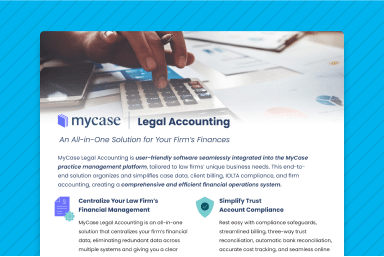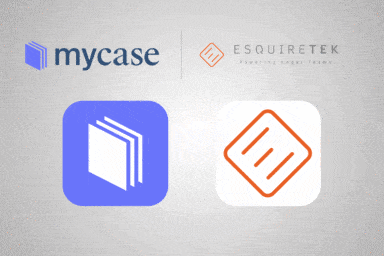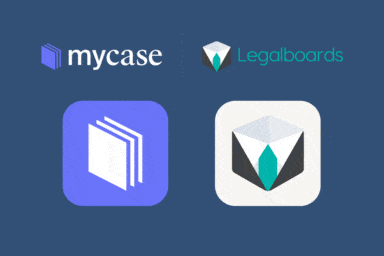Grow Your Law Firm With These 5 Attorney Billing Software Tips
By Nicole Black

For law firms, streamlined, effective legal billing software is incredibly important, since the more efficient your firm’s billing processes are, the more quickly your firm will get paid. When legal billing processes run smoothly, invoicing legal clients can be a painless – and fruitful – endeavor. But if your firm is relying on clunky, antiquated software and paper systems to send out invoices and collect overdue legal bills, it can be a time-consuming waste of precious resources.
Enter modern legal billing software. It ensures that your firm’s legal billing processes are efficient and accurate by reducing the steps needed to invoice clients and accept online payments. That’s why it’s so important to have legal billing software that helps your firm’s employees create streamlined processes in your law office that: 1) reduce the repetitive tasks associated with tracking and entering billable time, 2) simplify the invoice creation process, 3) make it easy to send invoices to clients, and 4) standardize the steps required to accept, receive, and account for payments.
Rest assured, accomplishing these goals is easier than it might sound. The trick is to ensure that your firm has legal billing best practices in place and takes advantage of billing software for attorneys that offers a robust set of features that ensure that legal invoices are sent out quickly and easily, and that your firm’s clients have multiple payment options.
Still not convinced that your firm needs robust legal billing software software? If your firm encounters any of the common legal billing hurdles discussed below, then guess what? It’s time to upgrade to a new billing system! So read on to learn about the most common billing problems law firms face, and find out how to put best practices in place to help your law firm overcome them.
Hurdle 1: Missed Billable Time
Many lawyers bill by the hour, and for those lawyers, time is money. Unfortunately, lawyers often get so busy with their day-to-day work that time-tracking falls by the wayside, causing them to lose track of billable hours that should be invoiced to their clients. That’s why it’s so important to ensure that your law firm’s legal billing processes are designed to help the firm’s attorneys keep track of their billable time, whether it happens in the office, in the courtroom, at home, or on the road.
Best Practice 1: Capture Time Automatically
Accurately capturing billable time is a common hurdle that attorneys face. Whether your firm’s attorneys bill hourly, or handle other types of matters like flat fee or contingency cases, keeping accurate records of your work can be critical. That’s where legal billing software comes in. Using it, lawyers in your firm can track their billable time from any internet-enabled device using multiple timers, making it easy for them to enter billable time no matter where they happen to be.
Another way to increase billing efficiency is to simplify the steps needed to convert billable activities into billable time on an invoice. Oftentimes, the billing software that your law firm uses can accomplish this goal in any number of ways. For example, with built in passive time tracking tools, all it takes is the click of a button to convert events or tasks into billable time. Another legal billing software timesaver is the ability to take advantage of default billing activity descriptions when entering billable time. After all, the easier it is for your attorneys to create a time entry, the more likely they are to do it.
Hurdle 2: Growing Time Investment
Legal billing processes vary greatly from one law firm to the next, and firms create and manage invoicing in many different ways using a variety of different processes and systems. Oftentimes these systems don’t work well together, if at all, resulting in invoicing and payment collection processes that can be inefficient and time-consuming.
Law firms that use disparate legal billing tools typically spend upwards of 10 to 15 hours creating invoices every week. This lengthy process is often unnecessarily complicated and bulky, in large part because law firms are often using multiple software tools to get the job done – and oftentimes the systems in place don’t communicate well. For example, time-tracking occurs on one software tool, invoices are generated in another, and client payments are received through a third software program. This convoluted and inefficient process means that reconciling the different data sources and ensuring invoicing continuity can become a nightmare to manage.
Best Practice 2: Batch Bill + Automate Time Reconciliation
A single centralized billing software solution solves this problem. With all of the billing data is collected and stored in one online location, it’s a simple process to create invoices from the billable time entered into the system, send multiple invoices at once via batch billing that include online payment links to clients that can be paid with the click of a button, and then accept online payments from clients within that same software. No more duplicate data entry or reconciliation across software tools; robust legal billing software does all of that for you!
Hurdle 3: Payment Inaccessibility
Another common challenge law firms face is collecting client payments. Oftentimes the billing processes that work best for law firms can create stumbling blocks for their clients. Legal clients want options and flexibility when it comes to paying their legal bills; the more choices you give them, the more likely they are to pay invoices in a timely manner. That’s why it’s so important to ensure that your law firm’s payment collection process is client-friendly.
Best Practice 3: Eliminate Common Roadblocks to Client Payment
The simplest way to eliminate the impediments that prevent clients from paying invoices is to take advantage of your firm’s legal billing software features and provide multiple online payment options for your firm’s clients. Credit card and online payments are the norm these days. Legal consumers assume that law firms will offer those payment options, and with online payment processing software, clients can easily make automated clearing house (e-check) or credit card payments online from the safety and comfort of their own homes. Not only will your firm get paid faster, but your clients will also have more choices when it comes to paying their legal bills. In other words, it’s a win-win for both your firm and its clients.
Hurdle 4: Delinquent Payments
In an ideal world, legal clients would pay their bills immediately, with no questions asked. Unfortunately, that’s not always the case, and clients sometimes are delinquent in making payments or fail to pay entirely. Following up on overdue invoices and seeking payment from non-paying clients can be a frustrating and time-consuming process, but fortunately modern legal software can solve this problem.
Best Practice 4: Automate Payment Reminders & Tracking
There are many different ways that lawyer billing software can ease the frictions encountered when collecting overdue payments from clients. One option is to reduce the need to do so right from the start. For example, consider setting up payment plans for your firm’s clients.
Using your firm’s legal billing software, you can create the payment plan, establish the amounts due and due dates, and share that information with your client, who can then instantly pay via e-check or credit card using your firm’s legal billing software with built-in online payment tools You can then set up invoice reminders for the amounts due, as discussed above. That way, your client has all the information needed to make regular payments under the payment plan, and will receive convenient reminders when the payments are due.
Related: [Blog Post] The Case for Law Practice Management Software
Hurdle 5: Disparate Solutions
When your firm’s legal billing tools are siloed in different legal software products, the result is inefficiency and error-prone billing. It can be painful when your firm’s legal billing tools are incompatible, and the process of reconciling billing and payment data across systems can be painstakingly difficult and complex. Fortunately, your law firm has a better choice: legal billing software with online payment processing tools built-in.
Best Practice 5: Use an Integrated Payments Solution
If your law firm is struggling with disparate legal invoicing and payment systems, then you’re in luck: law practice management software with built-in legal billing features offers the perfect solution for 21st century law firms seeking a centralized location for all of their financial information. In other words, there’s no better way to stay on top of law firm finances than using robust legal billing software that streamlines your law firm’s billing processes and provides your clients with the convenient and flexible legal payment options they expect.
For even more information on that ways that the legal billing features built into law practice management software can help your firm maintain financial stability and get paid quickly, make sure to watch this webinar: “5 Billing Best Practices From Top-Performing MyCase Customers.”


